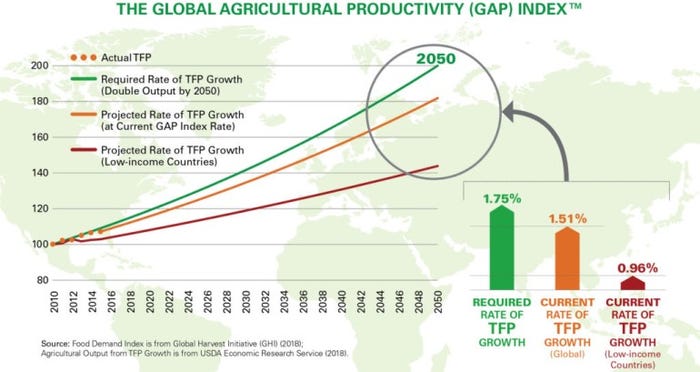Lagging productivity growth limiting ag’s global capacity
Global Harvest Initiative releases latest GAP report on global agricultural productivity.

Improved food production relies heavily on public agricultural research and development (R&D) and extension systems as well as regulatory frameworks that incentivize risk-taking innovation and investment. The Global Harvest Initiative released its 2018 Global Agricultural Productivity Report (2018 GAP Report) which highlights the critical investments needed in public policies such as research, improving trade, embracing science and information-technologies and public-private partnerships.
“Innovation and productivity are essential to keeping pace with the quantity and quality of food that consumers are demanding. We all have a role to play in creating a healthier, more sustainable world. The power of robust public research and strong public policy are often over-looked,” said Doyle Karr, biotechnology public policy director, Corteva Agriscience, the agriculture division of DowDuPont, and chair of the GHI Board of Directors.
According to the GAP Report, global agricultural productivity must increase by 1.75% annually to meet the demands of nearly 10 billion people in 2050. GHI’s annual assessment of global productivity growth – the GAP Index™ – shows the current rate of growth is only 1.51%.
The rate of agricultural productivity growth for low-income countries is particularly troubling, reaching only 0.96% annually – a downward trend from 1.31% in 2016 and 1.24% in 2017.
This is well below the productivity growth rate needed to achieve the Sustainable Development Goal 2 (SDG 2) target of doubling productivity for small-scale farmers in low-income countries and achieving Zero Hunger by 2050.

Keith Fugile, economist at the U.S. Department of Agriculture’s Economic Research Service, said TFP stems mostly from policy interventions and commitment to increase research and development as well as market mobilization in terms of encouraging private sector investment and offer incentives for farmers to invest in the farms. These are lacking in low-income countries, where agricultural sectors are often the largest, and unable to see growth, Fugile said during a panel discussion on the sidelines of the World Food Prize Borlaug Dialogues in Des Moines, Iowa.
The report notes that doubling agricultural productivity remains the “right goal.” The previous 10 years have witnessed unprecedented demand for agricultural commodities, driven by income increases and population growth in China and India, as well as demand for biofuels stimulated by high energy prices.
Over the next decade, the Organization for Economic Cooperation and Development (OECD) and the United Nations Food and Agriculture Organization (FAO) project that the rate of demand growth for all agricultural commodities will slow compared with the last decade. The rate of demand growth for cereal grains, meat, fish and vegetable oil will be cut nearly in half, the notable exception being increasing demand for fresh dairy, the GAP report identified.
The projected slowdown in demand for food and agriculture products over the next decade has prompted calls for a reduction in the agricultural output targets for 2050. “Yet a large and growing body of sophisticated modeling by agricultural economists examining long-term scenarios for agriculture, food and the environment indicates that it may be too soon to consider revising these goals downward,” the report noted.
The Agricultural Model Intercomparison and Improvement Project (AgMIP) - an international collaborative effort to improve agricultural economic models - analysis of 10 leading global multi-sectoral projection models found that world agricultural production of crops and livestock between 2005 and 2050 will need to rise by between 60 and 111%, with demand growth particularly strong for ruminant products (cows, sheep) as well as for commodities used in the production of biofuels – sugar, coarse grains and oilseeds.
Farmers getting ahead of consumers
Julie Kenney, Iowa deputy secretary of agriculture as well as a fifth-generation farmer with her husband in Story County, said in order to be productive it is not just about boosting yields with the best technology, but in an economic way as well as conserving the environment. It’s important to invest in research and make sure there are markets for products. The focus is also on the next generation, she said of her 7-year-old son. “We’re economically viable so there’s something for them to come back,” Kenney said.
Kenney, who has hosted consumers on her farms, said most consumers don’t want to prescribe certain methods of production for farmers, but want to feel good about what farmers are producing. “They want to know the people who produce their food. They also want to feel good about what we’re doing in terms of the environment, including the water around us and downstream.”
She said it’s important for those in agriculture to get out in front of prescribed ways of producing food, and make sure practices economically can conserve natural resources. She shared how by analyzing data on her farm, there were certain areas in particular fields that were not profitable. Their operation voluntarily took those lower performing acres out of production and converted to prairie grass, not as part of a government program, but economically evaluating that farm.
The GAP Report can be found on www.globalagriculturalproductivity.org.
About the Author(s)
You May Also Like





